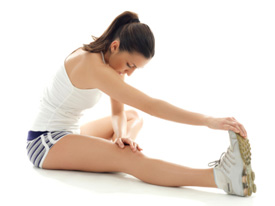Stretching – we all know we should do it, but how? And what types of stretch are best?
The how could fill volumes, but let’s talk a bit about the what.
There are several categories of stretching. Each has its benefits and its role.
Static stretching
 This is the classic stuff from high school gym class. Static stretching involves holding a stretch in a position that elongates and challenges the muscle without going to the point where it causes pain.
This is the classic stuff from high school gym class. Static stretching involves holding a stretch in a position that elongates and challenges the muscle without going to the point where it causes pain.
How far you should stretch and for how long is dependent on your age, fitness level, and any pre-existing injuries or medical conditions. The more you stretch, and the further you stretch, the more you will improve your flexibility and range of motion.
In most cases, you would hold a static stretch for 10 to 30 seconds.
But when should you do static stretches? Current thinking is that static stretching is best performed after exercise – when your muscles are warmed up. This improves their elasticity and flexibility. Your ligaments and joints will be more elastic as well. This allows you to push a good stretch with much less risk of injury than if your muscles are still cold and stiff. It also helps you reduce how much muscles may stiffen up as a result of exercise.
How often should you stretch? Every day, of course.
Examples of static stretching include:
Hamstring stretch: Sit on the ground with the right leg extended in front of you and the left leg folded so your left foot is pressed against the inner side of your right knee. Now reach forward with your right hand to grasp the toes of your right foot. Then switch sides to stretch the other leg.
Quadriceps stretch: Stand tall with your hand braced on a wall or chair for balance if you prefer. Grasp the left heel with the left hand and pull toward the buttocks. Keep knees close together. Repeat for the other side.
Dynamic stretching
Dynamic stretches are ones where you are moving as part of the stretch. You move through a comfortable range of motion and repeat 10 or 12 times.
This is considered the ideal pre-exercise form of stretching versus static stretching because it activates the muscles you will use during exercise. By activating the muscles you are going to use in that soccer game or while lifting those weights you will have:
- Improved awareness of your body and any problem areas
- Greater range of motion and flexibility
- Shaken off any stiffness from, say, sitting at a desk all day
- Increased muscular performance and power
All this makes it easier to get active with your chosen activity with reduced risk of injury.
Dynamic stretching should not be confused with ballistic stretching. The difference is that dynamic stretching is controlled, smooth, and deliberate, whereas ballistic stretching is more uncontrolled and jerky. For most of us, the risks of injury from ballistic stretching outweigh any benefits.
Examples of dynamic stretching include:
Knee to chest: Raise your knee to the chest while standing, with the option of hugging the shin for a greater stretch. Alternate between both legs while standing still or while walking. This stretches the hamstrings and glutes.
Hip stretch with a twist. This is great if you spend all day at a desk. Check out this video.
Active versus passive stretching
These are just a further categorization of static and dynamic stretches.
Active stretching means you are the one stretching the muscle by contracting its opposite muscle – like grabbing your ankle and pulling your heel up to your buttock to contract the hamstring and stretch the quadricep.
Passive stretching means you are using some kind of outside assistance to achieve the stretch, such as applying your own body weight, using a strap, or having another person’s help. Whatever the assistance, you are relaxing the muscle you are trying to stretch and relying on that external force to reach and hold the position.
Active stretching can be considered lower risk for injury than passive stretching because you are in control of the force.
